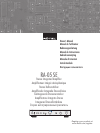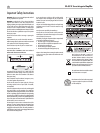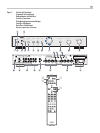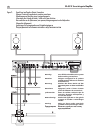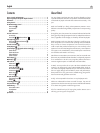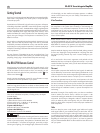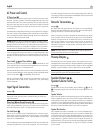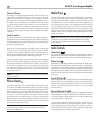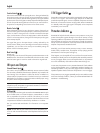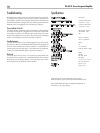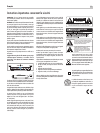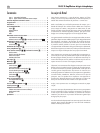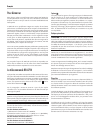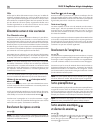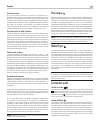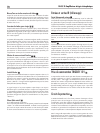
8
RA-05 SE Stereo Integrated Amplifier
Polarity and Phasing
The polarity – the positive/negative orientation of the connections – for
every speaker and amplifier connection must be consistent so all the
speakers will be in phase. If the polarity of one connection is reversed,
bass output will be very weak and stereo imaging degraded. All wire
is marked so you can identify the two conductors. There may be ribs
or a stripe on the insulation of one conductor. The wire may have clear
insulation with different color conductors (copper and silver). There may
be polarity indications printed on the insulation. Identify the positive and
negative conductors and be consistent with every speaker and amplifier
connection.
Speaker Connection
Turn off all the components in the system before connecting the speakers.
The RA-05 SE has color-coded binding post type speaker connectors on
the back panel (except in European Community countries where their use
is not permitted). These connectors accept bare wire, connector lugs, or
dual banana type connectors.
Route the wire from the RA-05 SE to the speakers. Give yourself enough
slack so you can move the components to allow access to the speaker
connectors. If you are using dual banana plugs, connect them to the wires
and then plug into the backs of the binding posts. The thumbscrews of the
binding posts should be screwed in all the way (clockwise).
If you are using terminal lugs, connect them to the wires. If you are attaching
bare wires directly to the binding posts, separate the wire conductors
and strip the insulation from the end of each conductor. Be careful not
to cut into the wire strands. Unscrew (turn counterclockwise) the binding
post thumbscrews. Place the connector lug or wire around the binding
post shaft. Turn the thumbscrews clockwise to clamp the connector lug
or wire firmly in place.
NOTE: Be sure there are no loose wire strands that could touch adjacent
wires or connectors.
Phones Output
4
The Phones output allows you to connect headphones for private listening.
This output accommodates standard stereo phone (1/8”) plugs. Plugging
in a set of headphones does not cut off the signal to the outputs. Use the
Speaker Selector to turn off the speakers. The settings of the Function
Selector and the Tape Monitor Control determines which source is heard.
To listen to or monitor the component connected to the Tape input set
the Monitor Control to the Tape position. For all other inputs leave the
Monitor Control in the Source position and select the source you want to
listen to with the front panel Function Selector or press the corresponding
source button on the remote control.
NOTE: Because the sensitivity of speakers and headphones can
vary widely, always reduce the volume level before connecting or
disconnecting headphones.
Media Player
5
A 3.5mm (1/8”) stereo input socket for a “Media Player” is provided on
the front of the amplifier and is selected by setting the function control
to (AUX2). Any portable stereo cassette, compact disc player or hard
disc playback device can be connected via this input. If the device you
are connecting has its output via the headphone socket then note that
you must adjust the volume control on the player for sound to be heard.
Should the sound be loud and distorted turn down the volume on the
player and if it is only just audible through the speakers even when the
amplifier volume control is turned up fairly high then adjust the volume
control on the player.
NOTE: When the 3.5mm (mimi jack) is inserted into the Media Player
socket the rear input called AUX2 is disconnected. Removing the
3.5mm plug from the Media player socket will allow the rear AUX2
input to function.
Audio Controls
Volume Control
-
f
Turn the controls clockwise to increase the volume, or counter clockwise to
decrease the volume. Or use the remote control volume buttons. Press the +
button to increase the volume, or the – button to decrease the volume.
Balance Control
=
The Balance Control adjusts the left-to-right balance of the sound output.
Normally the control should be left in the center position. In some situations,
typically when the main listening position is not ideally centered between
the speakers, it may be necessary to adjust the control to achieve proper
left-to-right balance. Turning the control counter-clockwise shifts the sound
balance to the left. Turning the control clockwise shifts the sound balance
to the right.
Tone On/Off Switch
0
When the Tone Switch is in the Off position the Bass and Treble Control
(Tone Control) circuits are bypassed to ensure the purest possible sound.
Leave the Tone Switch in the Off position unless you want to use the Tone
Controls. Turn the Tone Switch to the On position if you want to adjust
the Tone Controls.
Bass and Treble Controls
8
9
When the Tone Switch is in the On position, turning the Bass and Treble
Controls adjusts the tone balance of the sound. Turn the Controls clockwise
to increase the bass or treble output. Turn the Controls counterclockwise
to decrease the bass or treble output.
A properly setup high-performance audio system produces the most
natural sound with little or no adjustment of the tone controls. Use these
controls sparingly. Be particularly careful when turning the controls up
(clockwise). This increases the power output in the bass or treble range,
increasing the load on the amplifie and speakers.



